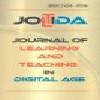Korea’s Blended Learning in Nursing: Issues and the Way Forward
Korea’s Blended Learning in Nursing: Issues and the Way Forward
Blended Learning, Nursing Education, Scholarly Flaws the Way Forward,
___
- Bonk, C. J. & Graham, C. R. (Eds.). (2005). Handbook of blended learning: Global perspectives, local designs. San Francisco, CA, USA: Pfeiffer Publishing.
- Kirkley, J. R., & Kirkley, S. E. (2005). Expanding the boundaries of blended learning: Transforming learning with mixed and virtual reality technologies. In C. J. Bonk & C. R. Graham (Eds.), Handbook of blended learning: Global perspectives, local designs (pp. 533-549). San Francisco, CA, USA: Pfeiffer Publishing.
- Kirkley, S. E., & Kirkley J. R. (2007). Creating next generation blended learning environments using mixed reality, video games and simulations. TechTrends, 49(3), pp. 42-53.
- Park, C. S. (2016). Nursing education's future: Blended learning [Editorial]. Journal of Learning and Teaching in Digital Age, 1(1), 2. Retrieved from http://joltida.org/index.php/joltida/article/view/2
- Wisher, R. A. (2005). Blended learning in military training. In C. J. Bonk & C. R. Graham (Eds.), Handbook of blended learning: Global perspectives, local designs (pp. 519-532). San Francisco, CA, USA: Pfeiffer Publishing.
- Yayın Aralığı: 2
- Başlangıç: 2016
- Yayıncı: Mehmet Akif Ocak
Effect of Flipped Learning on Cognitive Load: A Higher Education Research
Celal KARACA, Mehmet Akif OCAK
Examination of the Computational Thinking Skills of Students
Agah Tugrul KORUCU, Abdullah Tarık GENCTURK, Mustafa Mucahit GUNDOGDU
Korea’s Blended Learning in Nursing: Issues and the Way Forward
Utilization of Cinematographic Elements for Production of Educational Films
